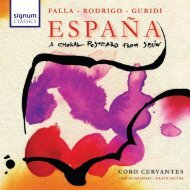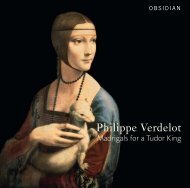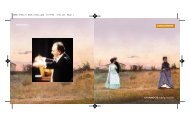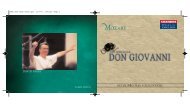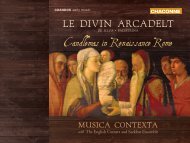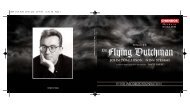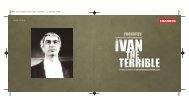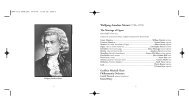You also want an ePaper? Increase the reach of your titles
YUMPU automatically turns print PDFs into web optimized ePapers that Google loves.
<strong>Olivier</strong> <strong>Messiaen</strong><br />
COMPLETE ORGAN WORKS VOL IV<br />
Timothy Byram-Wigfield<br />
The Organ of St George’s Chapel<br />
Windsor Castle<br />
La Nativité du Seigneur<br />
L’Ascension<br />
Messe de la Pentecôte<br />
Offrande au Saint Sacrement<br />
Prélude<br />
Diptyque<br />
Verset pour la Fête de la Dédicace
<strong>Olivier</strong> <strong>Messiaen</strong> (1908-1992)<br />
COMPLETE ORGAN WORKS VOL IV<br />
Timothy Byram-Wigfield<br />
The Organ of St George’s Chapel<br />
Windsor Castle<br />
Disc I<br />
La Nativité du Seigneur<br />
1. I. La Vierge et l’Enfant [7:38]<br />
2. II. Les Bergers [7:16]<br />
3. III. Desseins éternels [6:53]<br />
4. IV. Le Verbe [12:56]<br />
5. V. Les Enfants de Dieu [3:28]<br />
6. VI. Les Anges [3:47]<br />
7. VII. Jésus accepte<br />
la souffrance [5:13]<br />
8. VIII. Les Mages [8:10]<br />
9. IX. Dieu parmi nous [9:57]<br />
Disc II<br />
L’Ascension<br />
1. I. Majesté du Christ demandant<br />
sa gloire à son Père [6:42]<br />
2. II. Alléluias sereins d’une âme<br />
qui désire le ciel [5:36]<br />
3. III. Transports de joie d’une<br />
âme devant la gloire du Christ<br />
qui est la sienne [5:15]<br />
4. IV. Prière du Christ montant<br />
vers son Père [10:32]<br />
5. Diptyque [11:38]<br />
Recorded on 11 & 15 -17<br />
July 2008 in St George’s Chapel,<br />
Windsor Castle by kind permission<br />
of the Dean and Canons of Windsor<br />
Producer: Paul Baxter<br />
Engineer: Beth Baxter<br />
24-bit digital editing: Simon Smith<br />
24-bit digital mastering: Paul Baxter<br />
Instrument built & maintained<br />
by Harrison & Harrison Ltd<br />
Photograph editing: Raymond Parks<br />
Cover image: <strong>Messiaen</strong> at the organ<br />
of La Trinité in 1938 (private collection<br />
of Nigel Simeone)<br />
Design: John Christ<br />
Booklet editor: John Fallas<br />
Delphian Records Ltd – Edinburgh – UK<br />
www.delphianrecords.co.uk<br />
10. Offrande au Saint Sacrement [4:37]<br />
11. Prélude [8:39]<br />
NB At the time of recording,<br />
St George’s Chapel was cleared<br />
of soft furnishings in order for its<br />
stonework to be cleaned. This fact<br />
is responsible for the extended<br />
reverberation time and enhanced<br />
frequency response which can be<br />
observed on this disc compared to<br />
other recordings made in the Chapel.<br />
Messe de la Pentecôte<br />
6. I. Entrée (Les langues de feu) [2:33]<br />
7. II. Offertoire (Les choses<br />
visibles et invisibles) [12:28]<br />
8. III. Consécration (Le don<br />
de Sagesse) [4:08]<br />
9. IV. Communion (Les oiseaux<br />
et les sources) [5:59]<br />
10. V. Sortie (Le vent de l’Esprit) [3:36]<br />
11. Verset pour la Fête de<br />
la Dédicace [11:03]<br />
Total playing time (2 CDs) [2:18:38]
Notes on the music<br />
<strong>Messiaen</strong> had already been studying at the<br />
Paris Conservatoire for seven years when<br />
he joined Marcel Dupré’s preparatory organ<br />
class in autumn 1927, aged eighteen (he<br />
turned nineteen in December of that year);<br />
he made very rapid progress, moving into<br />
the senior class the following academic year<br />
and winning a first prize for organ in the<br />
summer 1929 concours.<br />
From the autumn of 1929 onwards, <strong>Messiaen</strong><br />
was the regular deputy for the Trinité’s ailing<br />
titulaire Charles Quef, but he wasn’t only earning<br />
a living as a church organist. As recently<br />
discovered correspondence with his cousin Paul<br />
Mergier reveals, <strong>Messiaen</strong> was also playing the<br />
organ in some unlikely venues: he worked at<br />
the famous Parisian music-hall L’Olympia as a<br />
cinema organist, and for a time in 1930 he was<br />
even considered for a permanent job there (the<br />
theatre’s administrator wrote to Dupré asking for<br />
an opinion, and <strong>Messiaen</strong> wrote to his cousin<br />
that ‘it interests me, but I don’t yet know if<br />
anything will come of it’); he also played for<br />
movies at the Théâtre Pigalle. 1<br />
Early in 1930, during his final year of studies<br />
at the Paris Conservatoire, <strong>Messiaen</strong> gave<br />
the premiere of his Diptyque at La Trinité in<br />
1 Anik Lesure and Claude Samuel (ed.), <strong>Olivier</strong> <strong>Messiaen</strong>: le livre<br />
du centenaire (Lyon: Symétrie, 2008), p. 36.<br />
2 They were noted in the Bulletin semestriel des Amis de l’Orgue,<br />
December 1929, p. 2.<br />
one of the concerts organised by Les<br />
Amis de l’Orgue. This was an occasion of<br />
considerable significance as it was the young<br />
<strong>Messiaen</strong>’s concert debut in Paris. It took<br />
place on 20 February 1930, and there is a<br />
short biographical note on the young organistcomposer<br />
in the programme: ‘Born in 1908,<br />
<strong>Olivier</strong> <strong>Messiaen</strong> has studied music at the<br />
Conservatoire where he won a premier prix<br />
for organ (1929), premiers prix in fugue,<br />
accompaniment and music history, a<br />
deuxième prix for harmony and another for<br />
composition. A pupil of M. Marcel Dupré,<br />
with whom he continues to study the organ,<br />
O. <strong>Messiaen</strong> gave two organ recitals last<br />
summer at Tencin (Isère).’ These concerts,<br />
in a small town just to the north-east of<br />
Grenoble, were apparently <strong>Messiaen</strong>’s first<br />
public organ recitals anywhere, given on<br />
15 and 22 September 1929. 2<br />
The Diptyque is described in the programme<br />
as ‘unpublished’ but ‘in preparation from<br />
Durand’ – it was issued in May 1930 and was<br />
the first music of <strong>Messiaen</strong>’s to appear in<br />
print. The work is described in a short note<br />
by <strong>Messiaen</strong> with the mixture of musical and<br />
theological commentary that was to become<br />
characteristic:<br />
The composer is at present a composition<br />
pupil of Paul Dukas. The first part of this work<br />
expresses the anguish and useless torment of<br />
life. It is a prelude in C minor containing four<br />
statements of the same theme, separated by<br />
short developments. The second part takes up<br />
the theme of the first and transforms it. An adagio<br />
in C major, based on a single serene, ascending<br />
phrase, it expresses the peace and charity of<br />
Christian paradise.<br />
As a student and during his early years<br />
at La Trinité, <strong>Messiaen</strong> composed several<br />
other short organ pieces: some of them<br />
remain unpublished, but two have been<br />
issued since his death. Offrande au Saint-<br />
Sacrement probably dates from around 1930,<br />
and the Prélude perhaps from a little later.<br />
The Offrande is a characteristic <strong>Messiaen</strong><br />
meditation and the composer noted on the<br />
manuscript that the music was ‘bien’. The<br />
Prélude is a more complex and extended<br />
piece, probably written in the early 1930s.<br />
After an energetic campaign – supported<br />
by letters of recommendation from Widor,<br />
Tournemire and Dupré – <strong>Messiaen</strong> was<br />
appointed to his post at La Trinité in<br />
September 1931, and for the next six<br />
decades he took his duties there very<br />
seriously, but before his appointment<br />
<strong>Messiaen</strong> had to reassure the Curé that<br />
he wouldn’t play anything that might alarm<br />
the parishioners. In a letter of 8 August<br />
1931 he wrote about ‘dissonant music’:<br />
When I was deputising at the Trinité, I know that<br />
I sometimes exhibited tendencies which were a<br />
little too modern, and I regret that now. I was only<br />
twenty years old when I deputised for the first<br />
time; I am now twenty-two-and-a-half, and at this<br />
time of life one evolves very quickly. My current<br />
view is that music should always search for the<br />
new, but in works for chamber ensembles or<br />
orchestra, where the imagination can run free.<br />
For the organ, especially the organ in church, what<br />
matters above all is the liturgy. The environment<br />
and the instrument are not well suited to modern<br />
music and it is important not to disturb the piety of<br />
the faithful by using chords which are too anarchic.<br />
[…] I can be well-behaved and classical in style.<br />
I will adopt this and both you and the parishioners<br />
will thus be satisfied. […] I completely share<br />
your opinion about the calmness and moderation<br />
required in a church service, musically speaking.<br />
The Cavaillé-Coll organ in the church also<br />
served as a kind of musical laboratory for the<br />
young composer: he was able to try out new<br />
ideas, to explore innovative sonorities, and<br />
to develop his musical language accordingly.<br />
However, three years after his appointment,<br />
the organ underwent an extensive restoration.<br />
By the time of the premiere of the original<br />
orchestral version of L’Ascension (on 9<br />
February 1935) the alternative for organ had<br />
already been published and played in public<br />
by <strong>Messiaen</strong>. This transcription had the newlycomposed<br />
‘Transports de joie d’une âme
Notes on the music<br />
devant la gloire du Christ qui est la sienne’,<br />
written during 1934, as a replacement for the<br />
original orchestral movement, ‘Alléluia sur la<br />
trompette, Alléluia sur la cymbale’. <strong>Messiaen</strong><br />
considered this colourful and decidedly Dukaslike<br />
orchestral scherzo unsuitable for the<br />
organ, and substituted a new and dazzlingly<br />
idiomatic toccata – the first of several such<br />
pieces he was to write for organ.<br />
Since the organ at La Trinité was out of<br />
commission, the first performance of the<br />
organ version, given on 29 January 1935<br />
by <strong>Messiaen</strong> himself, was at the church of<br />
Saint-Antoine-des-Quinze-Vingts (near the<br />
Gare de Lyon). The recital was reviewed in<br />
Le Ménestrel (3 February 1935) by a critic<br />
identified only as ‘M.P.’: ‘Receiving its first<br />
performance, M. <strong>Messiaen</strong> gave us his<br />
L’Ascension, a poem in four movements,<br />
written in a very refined style with colours<br />
which often seem more orchestral than<br />
organistic, and of a mystical tendency. This<br />
serenity expresses itself sometimes through<br />
quite turbulent music which is adjacent to<br />
passages of great poetry, of real beauty.’<br />
Félix Raugel in Le Monde musical (28 February<br />
1935), after claiming (incorrectly) that the organ<br />
version had been conceived first, went on to<br />
describe <strong>Messiaen</strong>’s achievement in terms<br />
that must surely have delighted the composer:<br />
‘<strong>Messiaen</strong> has planned this symphonic<br />
paraphrase on the Gospels in a way which<br />
recalls the broad and luminous work of the<br />
master glassmakers in our cathedrals. An<br />
ardently religious soul expresses itself in these<br />
passionate pieces with a tumultuous daring,<br />
but also at times with a delicate sweetness.’<br />
<strong>Messiaen</strong> played L’Ascension again at La<br />
Trinité on 28 May 1935, as part of a recital he<br />
shared with Marcel Dupré to inaugurate the<br />
newly-restored organ, to which seven new<br />
stops had been added while the instrument<br />
was out of action.<br />
<strong>Messiaen</strong> spent the summer of 1935 in<br />
Grenoble, and it was there that he completed<br />
La Nativité du Seigneur, his longest and<br />
most original work to date. Lasting an<br />
hour, it is a series of nine ‘meditations’ on<br />
different aspects of the Nativity and the<br />
Incarnation, including musical portraits of<br />
familiar Christmas images – the Virgin and<br />
Child, the shepherds, the Magi and the<br />
Angels – but also more abstract theological<br />
subjects: God’s predestined plan for us to be<br />
his adopted children (‘Desseins éternels’),<br />
the Word of God (‘La Verbe’), and the Word<br />
made flesh in ‘Dieu parmi nous’, God among<br />
us, the climactic piece in the cycle, a blazing<br />
toccata based on three ideas that represent<br />
God descending from Heaven (the opening<br />
chords), His love for Jesus (a slower, gentler<br />
theme), and a joyous, leaping tune first heard<br />
in octaves. The result is one of <strong>Messiaen</strong>’s<br />
most blazingly affirmative final movements.<br />
For <strong>Messiaen</strong>, La Nativité was a work of the<br />
greatest importance, and the score (published<br />
in 1936) has a preface in which the composer<br />
chose to publish for the first time an account<br />
of the ‘modes of limited transposition’<br />
that he devised as the essential vocabulary<br />
for his harmonic and melodic language.<br />
This two-page introduction is marks a crucial<br />
stage in <strong>Messiaen</strong>’s musical development.<br />
It was also his earliest attempt to explain his<br />
compositional technique. But there was much<br />
more to his thinking behind La Nativité. At<br />
the first performance, each member of the<br />
audience was given a small piece of paper<br />
in which <strong>Messiaen</strong> set out his aims:<br />
The emotion, the sincerity of the musical work:<br />
To be at the service of the dogmas of<br />
Catholic theology;<br />
To be expressed by melodic and harmonic means:<br />
the progressive growth of intervals, the chord<br />
on the dominant, pedal notes, embellishments<br />
and extended appoggiaturas.<br />
Still more by rhythmic means: rhythms<br />
immediately preceded or followed by their<br />
augmentation and sometimes increased<br />
by a short note-value (half the added value).<br />
And above all by modes of limited transposition:<br />
chromatic modes, used harmonically, the strange<br />
colour of which derives from the limited number<br />
of their possible transpositions (2, 3, 4 and 6<br />
according to the mode).<br />
Theological subject matter The finest, since it<br />
contains all subjects.<br />
And this abundance of technical means allows<br />
the heart to overflow freely.<br />
That final phrase encapsulates <strong>Messiaen</strong>’s<br />
aesthetic position: all the technical procedures<br />
and innovations in his compositions were<br />
there to expand the emotional range of the<br />
music and to enhance its expressive power,<br />
to liberate the imagination – ‘to allow the<br />
heart to overflow freely’.<br />
Such was the extent of the press coverage<br />
of La Nativité that <strong>Messiaen</strong> prepared a fourpage<br />
leaflet containing extracts from reviews,<br />
several of them by composers. 3 Georges Auric<br />
admitted an interesting paradox: while he<br />
was reluctant to accept some of <strong>Messiaen</strong>’s<br />
ideas, he had a genuine enthusiasm for the<br />
music: ‘It seems to me that on many issues,<br />
we would be poles apart. […] So it is a great<br />
delight for me to write that some of these<br />
pieces are among the most beautiful and the<br />
most moving which I have looked at in a long<br />
time.’ Another composer, Henri Sauguet, was<br />
bowled over:<br />
In this work, comprising nine mystical meditations<br />
for organ on the Nativity of Our Lord Jesus<br />
Christ, <strong>Olivier</strong> <strong>Messiaen</strong> has achieved a perfect<br />
3 La Nativité du Seigneur: Neuf Méditations pour Orgue par <strong>Olivier</strong><br />
<strong>Messiaen</strong> (édité chez Alphonse Leduc en quatre fascicules).<br />
Extraits de Presse (Paris, c.1937-8).
Notes on the music<br />
and brilliant mastery of his art, at the same<br />
time as expressing a mystical sensibility of an<br />
incomparable nobility and quality. We would like<br />
to go into detail about each of these nine pieces,<br />
to describe their beauty. They are written in an<br />
extremely personal language, using a musical<br />
vocabulary which <strong>Olivier</strong> <strong>Messiaen</strong> has created<br />
himself, using particular modes which he calls<br />
‘modes of limited transposition’. In La Nativité<br />
du Seigneur, <strong>Olivier</strong> <strong>Messiaen</strong> has reached the<br />
highest level of religious expression which music<br />
can achieve. 4<br />
<strong>Messiaen</strong>’s later view of La Nativité made it<br />
clear just how significant a work it was in his<br />
musical development: ‘With the use of Hindu<br />
rhythms in La Nativité I produced the proof,<br />
at least I believe I did, that it was possible<br />
to write music for the organ other than in a<br />
post-Franckist aesthetic.’ He added that the<br />
work was partly an indirect homage to his<br />
composition teacher Dukas – ‘perhaps to his<br />
remarkable open-mindedness’. 5<br />
La Nativité du Seigneur was first performed<br />
complete at a concert given under the<br />
auspices of Les Amis de l’Orgue in La Trinité<br />
on 27 February 1936, played by three of<br />
his friends (Jean Langlais, Jean-Jacques<br />
Grunenwald and Daniel-Lesur); three<br />
4 Review for La Revue hebdomadaire, quoted in Extraits de Presse.<br />
5 Brigitte Massin, <strong>Olivier</strong> <strong>Messiaen</strong>: Une poétique du merveilleux<br />
(Aix-en-Provence: Alinéa, 1989), p. 172.<br />
months later, on 25 May, Line Zilgien gave<br />
an all-<strong>Messiaen</strong> recital at La Trinité including<br />
five movements from La Nativité. She was<br />
another Dupré pupil, and was <strong>Messiaen</strong>’s<br />
regular deputy until her early death from<br />
cancer in 1954 (when she was succeeded by<br />
Jean Bonfils). By the mid-1930s <strong>Messiaen</strong>’s<br />
music was being played by other organists:<br />
the second complete performance in Paris<br />
of La Nativité was given in La Trinité on 23<br />
February 1937 by the brilliant organist of Saint-<br />
Augustin, André Fleury. The whole cycle was<br />
played in public by the composer himself a<br />
couple of months earlier, at Rouen Cathedral<br />
(on 19 November 1936). Before the outbreak<br />
of World War II it was largely through his<br />
organ works that <strong>Messiaen</strong> became known<br />
abroad: for example, André Marchal, André<br />
Fleury, Noëllie Pierront and the composer<br />
himself played his music in London; and<br />
Virginie Schildge Bianchini gave a recital in<br />
New York (16 May 1938) which ended with<br />
four pieces by <strong>Messiaen</strong>.<br />
From 1945 onwards, the pattern of Sunday<br />
Masses at La Trinité included a midday Mass<br />
reserved for ‘modern music’. On Pentecost<br />
Sunday (13 May) 1951, <strong>Messiaen</strong> gave the<br />
first performance of two movements from his<br />
new Messe de la Pentecôte. He introduced<br />
the work to the congregation in the May issue<br />
of the Trinité’s parish magazine:<br />
For the midday mass, reserved for modern<br />
music, I have composed two pieces specially: an<br />
offertoire and a sortie. The offertoire comments<br />
on the words ‘Les choses visibles et invisibles’<br />
(‘All things visible and invisible’) which we recite<br />
each Sunday in the Creed, and which are applied<br />
perfectly to the kingdom of the Holy Spirit, an<br />
inner kingdom of invisible grace. The sombre<br />
colours of the registration, the construction with<br />
‘rhythmic characters’, the alternation of the 16-<br />
foot bassoon which growls in the extreme bass,<br />
with the piccolo and tierce making the sounds of<br />
distant bells in an extremely high register, depict<br />
the workings of grace. The sortie, entitled ‘Le Vent<br />
de l’Esprit’ (‘The Wind of the Spirit’), uses a text<br />
from the Acts of the Apostles: ‘A powerful wind<br />
from heaven filled the entire house’ (taken from<br />
the Epistle of the day). A fortissimo, at first very<br />
violent, rises up in rapid swirls, like a chorus of<br />
larks as a symbol of joy. 6<br />
With the Messe de la Pentecôte, <strong>Messiaen</strong><br />
set out to preserve and refine some of his<br />
most daring improvisations from the years<br />
immediately after the end of World War II. He<br />
wrote about its origins in Tome IV of the Traité<br />
de rythme, de couleur, et d’ornithologie:<br />
The work was written in 1950 but improvised long<br />
before then. Here is its history: I became organist<br />
of the grand orgue at the Trinité (Paris) in 1930<br />
6 <strong>Olivier</strong> <strong>Messiaen</strong>, ‘Orgue’, La Trinité: journal paroissial, May<br />
1951, p.3.<br />
[recte 1931] when I was just 22 years old. My<br />
duties required me to play short improvisations<br />
on plainsong texts, especially the verses and<br />
responses at Vespers. For other services I always<br />
played written pieces (Nicolas de Grigny, J.S.<br />
Bach, modern music). From 1945 onwards, at the<br />
midday Mass, I was allowed to play exclusively<br />
modern music, whether it was the works of my<br />
contemporaries or pieces I had written myself.<br />
I also improvised, in order more fully to become<br />
a part of the three great divisions of the Blessed<br />
Sacrifice: Offertory, Consecration, Communion;<br />
and to put into sharper relief the mysteries of the<br />
liturgical year, the grace proper to each mystery,<br />
the colour, poetry and particular feeling of each<br />
time and each feast; these improvisations gradually<br />
became ‘one’ improvisation, always forgotten,<br />
always found again, and always repeated: the<br />
terrifying groans of the Beast of the Apocalypse<br />
alternating with the songs of thrushes and<br />
blackbirds, the sounds of the water and of the<br />
wind in the trees with the religious meditation and<br />
the storms of joy of the Holy Spirit. Hindu rhythms<br />
were mixed with the neumes of plainchant, choirs<br />
of larks with Tibetan trumpets […] the strangest<br />
and the most shimmering sounds were alongside<br />
the clearest permutations or rhythmic interversions.<br />
The known and the unknown were both to be<br />
found there, the visible and the invisible, the<br />
world of men and the world of angels. And so it<br />
was that the Messe de la Pentecôte was born.<br />
Without being my best work, it is without doubt<br />
the one which is closest to my true nature, and
Notes on the music<br />
the only one intended entirely for my organ at the<br />
Trinité (of which it uses all the timbres and their<br />
combinations), since it had been improvised many<br />
times there, during the years 1948 and 1949.<br />
I wrote it down on manuscript paper in 1950.<br />
Then I gave up improvising altogether. 7<br />
Happily, any abandonment of improvisation<br />
was short-lived. But apart from the Messe de<br />
la Pentecôte, there is little evidence for what<br />
<strong>Messiaen</strong>’s liturgical improvisations in the late<br />
1940s sounded like. One account, however,<br />
is especially evocative: the writer Julien Green<br />
made a note in his diary on 18 April 1949<br />
about an improvisation that suggests the kind<br />
of blazing originality so characteristic of the<br />
Messe de la Pentecôte:<br />
Heard an improvisation by <strong>Messiaen</strong> on the radio.<br />
Music which one could say was composed after the<br />
end of the world. It is of monstrous beauty, opening<br />
up immense caverns where rivers flow, where<br />
mounds of precious stones glitter. We do not know<br />
where we are – in India perhaps. The composer was<br />
playing on the organ of the Trinité. Never have the<br />
vaults of this hideous edifice heard more disturbing<br />
sounds. Occasionally I had the impression that hell<br />
was opening, suddenly gaping wide. There were<br />
cataracts of strange noises that dazzled the ear. 8<br />
Plainsong inspired many of <strong>Messiaen</strong>’s<br />
improvisations, and he turned to it again when he<br />
wrote Verset pour la Fête de la Dédicace, based<br />
on a plainsong Alleluia set against a chorus of<br />
birdsong (the song thrush). Despite its title, this<br />
short work was not written for the dedication<br />
of a church but as a test piece for the Paris<br />
Conservatoire. The organ concours for which it<br />
was composed took place on 13 June 1961, and<br />
the Lebanese organist Raffi Ourgandjian was<br />
among those to win a premier prix.<br />
<strong>Messiaen</strong> was fiercely loyal to La Trinité over<br />
six decades. In the church’s parish magazine<br />
for March 1991, a year before his death, there<br />
was an interview to celebrate his sixty years<br />
as organist there. Aptly titled ‘Le musicien de<br />
la joie’, it included a question about whether<br />
all of his works were written to the glory<br />
of God. The composer gave a touching and<br />
modest reply: ‘I have written pure music (for<br />
the purposes of technical experimentation),<br />
and music of a secular character. I sometimes<br />
regret that a little. Music composed to sing<br />
the mysteries of my faith seems more useful<br />
for my contemporaries. Perhaps they will be<br />
grateful to me for that.’<br />
© 2009 Nigel Simeone<br />
Nigel Simeone is Professor of Historical<br />
Musicology at the University of Sheffield.<br />
He is co-author with Peter Hill of the<br />
biography <strong>Messiaen</strong> (Yale University Press,<br />
2005). The revised French edition of this<br />
book (<strong>Olivier</strong> <strong>Messiaen</strong>, Fayard, 2008) was<br />
awarded the Prix René Dumesnil by the<br />
Académie des Beaux-Arts, Paris, in 2008.<br />
7 <strong>Olivier</strong> <strong>Messiaen</strong>, Traité de rythme, de couleur, et d’ornithologie,<br />
Tome IV (Paris: Leduc, 1997), p. 83.<br />
8 From Julien Green, Journal (Paris: Plon, 1951). Vol 5: ‘Le<br />
Revenant (1946-1949)’.
The Organ of St George’s Chapel, Windsor Castle<br />
Harrison & Harrison of Durham, 1965/2002<br />
Pedal organ 20 stops<br />
1. Sub Bourdon 32<br />
2. Open Diapason 16<br />
3. Bourdon 16<br />
4. Dulciana 16<br />
5. Quintadena (from Swell) 16<br />
6. Principal (18 from no. 2) 8<br />
7. Flute (18 from no. 3) 8<br />
8. Dulciana (18 from no. 4) 8<br />
9. Fifteenth 4<br />
10. Röhrflöte 4<br />
11. Open Flute 2<br />
12. Mixture (19. 22. 26. 29) IV ranks<br />
13. Double Trombone (18 from no. 14) 32<br />
14. Trombone 16<br />
15. Fagotto 16<br />
16. Tromba (18 from no. 14) 8<br />
17. Bassoon (18 from no. 15) 8<br />
18. Octave Tromba (18 from no. 16) 4<br />
19. Schalmei 4<br />
20. Kornet 2<br />
i. Choir to Pedal<br />
ii. Great to Pedal<br />
iii. Swell to Pedal<br />
iv. Solo to Pedal<br />
Choir organ 15 stops<br />
21. Quintadena 8<br />
22. Gedackt 8<br />
23. Principal 4<br />
24. Spitzflöte 4<br />
25. Wald Flute 2<br />
26. Sesquialtera (12. 17.) II ranks<br />
27. Cimbel (29. 33. 36.) III ranks<br />
28. Krummhorn 8<br />
v. Tremulant<br />
On the Screen<br />
29. Diapason 8<br />
30. Lieblichflöte 8<br />
31. Octave 4<br />
32. Lieblichflöte 4<br />
33. Super Octave 2<br />
34. Mixture (19. 22. 26. 29.) IV ranks<br />
35. Trompette 8<br />
vi. Swell to Choir<br />
vii. Solo to Choir<br />
Great organ 13 stops<br />
36. Double Diapason 16<br />
37. Open Diapason I 8<br />
38. Open Diapason II 8<br />
39. Stopped Diapason 8<br />
40. Principal 4<br />
41. Open Flute 4<br />
42. Fifteenth 2<br />
43. Block Flute 2<br />
44. Cornet II–V ranks<br />
45. Mixture (19. 22. 26. 29.) IV ranks<br />
46. Double Trumpet 16<br />
47. Trumpet 8<br />
48. Clarion 4<br />
viii. Choir to Great<br />
ix. Swell to Great<br />
x. Solo to Great<br />
xi. Great Reeds on Pedal<br />
xii. Screen Choir on Great<br />
Swell organ 16 stops<br />
49. Quintadena 16<br />
50. Violin Diapason 8<br />
51. Lieblich Gedackt 8<br />
52. Echo Gamba 8<br />
53. Voix Celestes (from ten. c.) 8<br />
54. Principal 4<br />
55. Rohr Flöte 4<br />
56. Nazard 2 2 /3<br />
57. Fifteenth 2<br />
58. Tierce 1 3 /5<br />
59. Mixture (22. 26. 29. 33.) IV ranks<br />
60. Oboe 8<br />
61. Vox Humana 8<br />
62. Contra Fagotto 16<br />
63. Cornopean 8<br />
64. Clarion 4<br />
xiii. Tremulant<br />
xiv. Octave<br />
xv. Solo to Swell<br />
Solo organ 8 stops<br />
65. Cor de Nuit 8<br />
66. Concert Flute 4<br />
67. Viole d’Orchestre 8<br />
68. Viole Celeste 8<br />
69. Corno di Bassetto 8<br />
70. Orchestral Oboe 8<br />
xvi. Tremulant<br />
71. Orchestral Trumpet (unenclosed) 8<br />
72. Orchestral Clarion (unenclosed) 4<br />
xvii. Octave<br />
xviii. Sub Octave<br />
xix. Unison Off<br />
Eight toe pistons to the Pedal Organ<br />
Ten thumb pistons to the Choir Organ<br />
Eight thumb pistons to the Great Organ<br />
Eight thumb pistons to the Swell Organ<br />
Eight toe pistons to the Swell Organ<br />
Six thumb pistons to the Solo Organ<br />
Eight thumb General Pistons, duplicated by transfer<br />
on to Swell toe pistons<br />
Two adjustable pistons for all the couplers<br />
Eight lockable memories to the Divisional Pistons<br />
Thirty-two lockable memories to the General Pistons<br />
Stepper thumb and toe pistons (forward and reverse)<br />
Reversible pistons to Great to Pedal (thumb and toe),<br />
Swell to Pedal, Swell to Great (thumb and toe), Choir<br />
to Pedal, Solo to Pedal, Solo to Great, Choir to Great,<br />
Swell to Choir, Solo to Choir, Solo to Swell<br />
General cancel piston<br />
© 2005 St George’s Chapel, Windsor Castle<br />
All rights reserved
Timothy Byram-Wigfield<br />
Timothy Byram-Wigfield<br />
is Director of Music at St<br />
George’s Chapel, Windsor<br />
Castle, an appointment he<br />
has held since January 2004.<br />
In this capacity he directs<br />
the famous choir of men<br />
and boys in its schedule of<br />
daily services, as well as providing music for<br />
occasions of royal and national significance.<br />
As well as directing music for the annual<br />
service of the Knights of the Garter, he was<br />
privileged to direct the music for the Blessing<br />
service following the marriage of HRH Prince<br />
Charles and HRH The Duchess of Cornwall in<br />
2005. More recently, the Choir has taken part<br />
in events to mark HM The Queen’s eightieth<br />
birthday, and sung at the wedding of Peter<br />
Philips and Autumn Kelly. The Choir has also<br />
made a number of recordings on the Delphian<br />
and Naxos labels.<br />
As a choral conductor, Timothy Byram-Wigfield<br />
has worked with a number of large-scale and<br />
symphony choruses. From 1993 to 1998 he<br />
trained the Scottish Chamber Orchestra Chorus,<br />
preparing works for performances conducted<br />
by Sir Charles Mackerras, Ivor Bolton, Nicholas<br />
Kraemer, and Markus Stenz, amongst others.<br />
Alongside his work in Cambridge from 1999,<br />
as Director of Music at Jesus College, he was<br />
Conductor of the Northampton Bach Choir.<br />
He has deputised for rehearsals of many other<br />
choruses, including the London Bach Choir.<br />
He has recently been appointed the Associate<br />
Director of the Oxford Bach Choir.<br />
As an organist he has given recitals in<br />
many cathedrals in the UK, and toured to<br />
the USA, France and the Netherlands. A<br />
regular recording artist for Delphian Records,<br />
his recordings have consistently met with<br />
critical acclaim, including a disc of transcribed<br />
overtures from the celebrated Lewis organ<br />
in the Kelvingrove Hall, Glasgow (DCD34004),<br />
and a disc of music by the Edwardian Alfred<br />
Hollins (DCD34044). In 2009 he will record<br />
a second volume of overtures for Delphian,<br />
at the organ of Rochdale Town Hall.<br />
He is also active as a pianist, singer,<br />
composer and choral arranger. He teaches<br />
piano and organ at Eton College, and is a<br />
regular examiner for the diploma examinations<br />
presented by the Royal College of Organists.<br />
<strong>Messiaen</strong> organ music on Delphian<br />
<strong>Olivier</strong> <strong>Messiaen</strong>: Organ Works Vol I<br />
Les Corps glorieux, Le Banquet céleste & Apparition de l’Eglise éternelle<br />
Timothy Byram-Wigfield<br />
The Organ of St George’s Chapel, Windsor Castle<br />
DCD34024<br />
Timothy Byram-Wigfield presents <strong>Messiaen</strong>’s ground-breaking Les Corps<br />
glorieux on the organ of St George’s Chapel, with its protean personality.<br />
Byram-Wigfield is an ideal exponent of this work and its extremities: from<br />
his sensitive approach to its spiritual narrative, to his thrilling handling of its<br />
gargantuan climaxes, the listener cannot fail to be drawn into <strong>Messiaen</strong>’s<br />
world of colour. This volume inaugurates Delphian’s survey of <strong>Messiaen</strong>’s<br />
complete published organ music, in which the early music is performed by<br />
Byram-Wigfield and the late works by Michael Bonaventure.<br />
<strong>Olivier</strong> <strong>Messiaen</strong>: Organ Works Vol III<br />
Le Livre du Saint Sacrement<br />
Michael Bonaventure<br />
The Rieger Organ of St Giles’ Cathedral Edinburgh<br />
DCD34076 (2 discs)<br />
The seeds for <strong>Messiaen</strong>’s final organ work were sown during an<br />
inspirational trip to Israel in 1984. Over the course of the following<br />
twelve months, <strong>Messiaen</strong> found improvisation leading him back<br />
to composition after the exhausting labours that had produced his<br />
mighty opera Saint François d’Assise. The Livre du Saint Sacrement<br />
became <strong>Messiaen</strong>’s grand farewell to his own instrument, and Michael<br />
Bonaventure performs it from memory here on the Rieger instrument at<br />
St Giles’ Cathedral, an organ of immense range and apocalyptic power.<br />
‘a magnificent achievement … utterly compelling’<br />
— BBC Music Magazine Instrumental Choice, Proms 2008 edition
DCD34078



